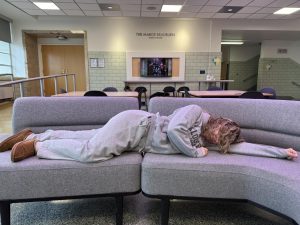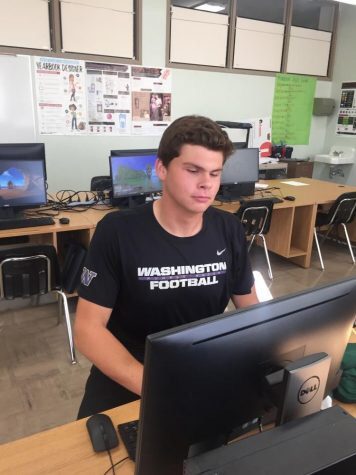How Football in the State of Washington has Become One of the Country’s Most Premiere Showings
December 7, 2017
College teams in Washington along with the northwest fan favorite Seattle Seahawks are either wrapping up very successful seasons or making a push for the playoffs. Yes, the State of Washington has become one of the country’s best on all levels for football. But this has not always been the case.
The football success began in 2008, when things were at the very worst in the state.
Washington and Washington State played in the 101st Apple Cup in Martin Stadium in Pullman. From the box score, this was a fantastic game. A double overtime thriller that ended in a WSU game winning field goal. On tape, this was not only one of the worst football games in not only both those programs history, but maybe all of college football.
It seemed as if nobody wanted to win. Sloppy mistake after sloppy mistake was made until the leg of Nico Grasu booted in a game winning field goal that gave Coug fans 24 hours of joy. Although their bragging rights were secure for a year, WSU faced the harsh reality of a 2-10 season. The 2008 Apple Cup would be then Washington State coach Paul Wullifs only win against the Huskies in his 3 year stand in Pullman.
So life wasn’t all bad on the Palouse.They had the trophy and bragging rights secure. As for their rival west of the Cascades, they had fallen into the deepest hole their program would ever be trapped in.
The overtime loss to WSU put UW’s 2008 record at 0-11. They had one last chance to win a game that next week against Cal in California Memorial Stadium. The city of Seattle rallied for this game. They supported their team and wanted to see that one win on the season. Washington head coach Tyrone Willingham wanted to end his 3 year stand as the head man on Montlake with one last W.
UW got steamrolled 48-7.
For the first time in program history, the Huskies were winless. Willingham was out as was the rest of the staff. Husky football had plunged deeper than any crevice in the lake near which their stadium stood on the shores omit.
College football was bust, as the states FBS teams were a combined 2-22 on the season. Things in downtown Seattle weren’t going much better for the NFL representative of the Evergreen State either.
The 2008 season was the year the Seattle Seahawks had fallen out of relevance in the NFL. Fresh off of 5 straight winning seasons and 4 NFC West titles as well as a trip to Super Bowl in 2005, the Seahawks finished 4-12 and missed the playoffs by a long shot. Pro Bowl quarterback and Seahawk great Matt Hasselbeck had battled injuries all year and only been able to play in 7 games, where his record as a starter was 6-1. He tossed 5 touchdowns in his 7 game stand, but complemented that with 10 interceptions. For the rest of the season, Charlie Frye and Seneca Wallace were the men under center for the Hawks. The first year without former MVP running back Shaun Alexander was rough, and it didn’t help that all time great offensive tackle Walter Jones was on his way out. At the end of the 2008 season, it was apparent that the franchise had gone into full blown rebuild mode.
To recap football in Washington State in 2008, the college and professional teams finished 6-34 all together. No championships, no awards, and a trophy in Pullman that nobody really deserved. It wasn’t going to be like this forever, right?
The turnaround began in 2009.
Washington hired Steve Sarkisian from USC, who took Husky football from awful to mediocre to pretty good.
Sark led UW to a 5-7 record in 2009, and after not winning a single game in 2008, 5 wins tasted like fine wine in the mouths of the purple and gold faithful. In 2010, Sarkisian led Washington to a 7-6 record and their first bowl game since 2002. Washington upset Nebraska 19-7. The effort was led by treasured Washington quarterback Jake Locker and running back Chris Polk.
The Huskies would go on to finish the next 2 seasons 7-6 and then in 2013, a 9-4 record capped with a win in the Fight Hunger Bowl against BYU. At the end of that Season, Sarkisian left Washington for the head job at USC. Dawg fans were upset, but his departure proved to be a blessing in disguise, as Sarkisian would be bombarded with allegations of alcohol abuse, which turned out to be true.
Washington then gave the head man on the blue turf a call and hired Chris Petersen in 2014. In 2014 and 2015, not much change was apparent between the squads led by Sarkisian and Petersen, as both led their teams to around a .700 win percentage and second tier bowl games. Fan moral was happy in Husky Stadium, but little did Dawg fans know the 2016 season was when Washington would return to not only Pac 12 supremacy, but put the mighty men in purple and gold atop the college football world.
Sark had turned things around things around in Husky Stadium and Petersen showed promise, but the rivals of Washington were making moves of their own. Washington State was made a hire that would take the program out of the basement of the PAC 12.
Mike Leach assumed the head coaching position at Washington State after the Cougars failed to make a bowl game since 2003. Leach inherited a program that had not had a winning season in 8 years and had burned through 2 head coaches in 7 years. Needless to say, Leach had work to do. His first year the Cougars posted a disappointing yet expected 3-9 record. Leach would then double his wins in 2013 as the Cougars finished 6-6, but after a loss in the New Mexico Bowl to Colorado State ended 6-7.
The next season WSU would finish 3-9 again, an unfortunate showing after qualifying for a bowl game for the first time in 10 years the prior season. People were skeptical about the hire of Leach after not having a record above .500 in his first 3 years, but in the summer of 2015 the winds shifted and blew the golden wheat of the poluse in a direction it hadn’t been pointed towards since the beginning of the 21st century- the top of the Pac 12.
While uncertainty was still evident in Pullman, a new head man was ready to put Seattle back on the map of professional sports.
After a brief stint in 2009 with Jim Mora, the Seattle Seahawks brought in USC head coach Pete Carroll, who had led the Trojans to the top of the college football world in his 9 years in Los Angeles. Carroll finished a 97-19 record while at USC and was ready to head back up to the NFL, after being out of the league since 1999. Carroll made his name in the pros where he coached for 15 years until taking the job at USC. He was a coach for the Buffalo Bills, Minnesota Vikings, New York Jets, and New England Patriots. The NFL was not anything new for Carroll.
Carroll led the Hawks to back-to-back 7-9 records in 2010 and 2011, but while those average records were being earned, GM Paul Schneider and Carroll kept a close eye on the names in the NFL draft. In 2011-2013, names such as Richard Sherman, Bobby Wagner, Doug Baldwin, Kam Chancellor, Earl Thomas, and of course Russell Wilson stolen in the Draft by Seattle.
The now superstar names taken by the Seahawks weren’t the outcome of several blockbuster trades for first round picks though. However, the big name players were taken in the 3rd, 4th, 5th, and even 7th rounds of the draft. The gut instinct of Schneider and Carroll to draft these now All-Pro and Pro-Bowl players is a testament to the 2nd and 3rd days of the NFL draft- where the true future of the league is taken.
Russell Wilson won the starting job over Matt Flynn in 2012 and led Seattle to an 11-5 record. A playoff berth was the reward for starting Wilson, and he led Seattle to the divisional round where the traveled to the peach state to have a valiant comeback attempt against the Atlanta Falcons come up just short. Seattle was done for the 2012 season, but the best was yet to come.
For the first time in 2013, behind the innate ability of Russell Wilson and the terrorization of offenses across the league by the self proclaimed Legion of Boom, Seattle won its first ever Super Bowl. The Hawks dominated the Peyton Manning led Denver Broncos 43-8 in Super Bowl 48, and showed the world they were back on top and had no intention of leaving. The next year they defended their Super Bowl title against the New England Patriots in Super Bowl 49, but an interception off Russell Wilson on an ill-advised pass play in the closing seconds of the game lifted the Patriots and Tom Brady to yet another ring and Seattle lost 28-24.
Despite the loss, Seattle had made back-to-back Super Bowls and had won their first Lombardi Trophy. Russell Wilson quickly showed he was the face of the franchise and Pete Carroll seemed to be a mad scientist who had created a monster which was to be unleashed on the rest of the league for years to come.
Seattle has made the playoffs the past 5 season and are looking to extend the streak to 6 this winter. Behind brilliant draft picks and the leadership of Pete Carroll, the Seahawks are back on top of the NFL.
The build up to the 2015 did not give Washington State football much expectation. But much like their professional counterparts in Seattle, the Cougars shocked the country and finished with a 9-4 record. Walk on quarterback Luke Falk seemed to come out of nowhere and orchestrated the WSU air raid offense to perfection. A win in the Sun Bowl finished the Cougars season and they were to return several players in 2016. There was so much promise in Martin Stadium, and the next season was going to be special for WSU.
Meanwhile, Washington posted a 7-6 record in 2015 and finished the season with a win in the Heart of Dallas bowl over Southern Mississippi.
The offseason was long, so much hype surrounded both programs. Washington entered the 2016 ranked 14th in the country, and Washington State was third in receiving votes for their name to be in the top 25. Both teams lived up to expectation and took care of business in September and October. Now, the game that had been a laughing stock to fans was to decide who represented the north in the Pac 12 title game. The stage was set for the Apple Cup.
On a rainy November day in Pullman, hate between the fans of the rivaling teams filled Martin Stadium with a nervous yet exciting mood. The ball was kicked off and a game that was anticipated to be one of the best the two teams had ever played against each other had begun.
In a way, it was somewhat better than the 2008 pillow fight of a game. This time, one of the teams showed up, better than either of them wanting to play in 2008.
Washington won 45-17.
The Huskies then went on to dominate in the Pac 12 title game and beat Colorado 41-10. The Huskies had made a national statement and the entire country had heard. Washington went on to make the College Football Playoff where they ran into the machine that is the University of Alabama football program and lost 24-7 in the Peach Bowl semi-final game. They finished the season 12-2.
Washington State, still licking their wounds from the Apple Cup, went on to face Minnesota in the Holiday Bowl in San Diego. The Cougars suffered a slow death by field goal at the hands of the Gophers and lost 12-7. WSU finished the season 8-5.
Pete Carroll had led the Seahawks to back-to-back Super Bowls, Chris Petersen had re-established Washington Football as a national powerhouse, and Mike Leach has led WSU to winning record and bowl game berths for the past 4 years.
A state that wanted to run and hide when the topic of football was up for discussion has become a hotbed for the premier beloved American sport. So the next time the question “where is the best football in the country?” is posed, give a nod to the Evergreen State, because as the last 9 years shows, it deserves it.





